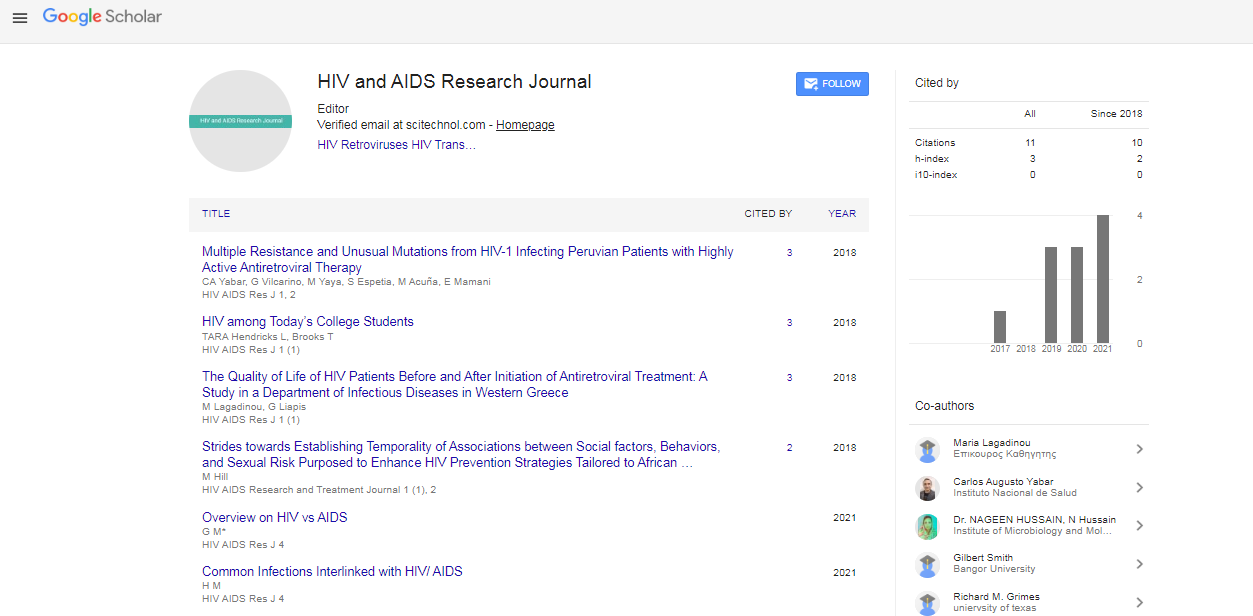Opinion Article, Hiv Aids Res J Vol: 6 Issue: 4
Innovative HIV Drugs and the Challenge of Drug Resistance
Lewis Hope*
1Department of Biotechnology, Osaka University, Osaka, Japan
*Corresponding Author: Lewis Hope,
Department of Biotechnology, Osaka
University, Osaka, Japan
E-mail: hope.lewis@gmail.com
Received date: 04 December, 2023, Manuscript No. HARJ-24-124135;
Editor assigned date: 06 December, 2023, PreQC No. HARJ-24-124135 (PQ);
Reviewed date: 20 December, 2023, QC No. HARJ-24-124135;
Revised date: 28 December, 2023, Manuscript No. HARJ-24-124135 (R);
Published date: 05 January, 2024 DOI: 10.4172/Harj.1000139
Citation: Hope L (2024) Innovative HIV Drugs and the Challenge of Drug Resistance. HIV AIDS Res J 6:4.
Description
The evolution of Antiretroviral Therapy (ART) has transformed the management of HIV/AIDS, yet drug resistance remains a significant concern. Antiretroviral drugs have revolutionized HIV treatment, significantly prolonging and improving the quality of life for individuals living with HIV. However, the emergence of drug-resistant strains poses a persistent threat to the efficacy of these medications. Understanding the mechanisms of drug resistance and exploring innovative HIV drugs are critical in addressing this challenge.
Innovative HIV Drugs
Integrase Strand Transfer Inhibitors (INSTIs): INSTIs, such as raltegravir, dolutegravir, and bictegravir, block the integration of viral DNA into the host genome by targeting the viral integrase enzyme. These drugs exhibit potent antiviral activity with a high barrier to resistance and are integral components of modern ART regimens.
Next-Generation Non-Nucleoside Reverse Transcriptase Inhibitors (NNRTIs): Novel NNRTIs, like doravirine, offer improved safety profiles, reduced drug interactions, and efficacy against certain NNRTI-resistant strains. Their development addresses challenges associated with resistance and side effects seen with earlier-generation NNRTIs.
Long-acting injectable therapies: Long-acting formulations of antiretroviral drugs, administered through injections every few weeks or months, offer an alternative to daily oral medications. Drugs like cabotegravir and rilpivirine have shown promise in maintaining viral suppression and improving treatment adherence.
Broadly neutralizing antibodies: It target various vulnerable sites on the HIV envelope glycoprotein, demonstrating the ability to neutralize a broad spectrum of HIV strains. Research into their potential use as therapeutic agents or for HIV prevention continues, although challenges such as dosing and durability remain.
Mechanisms of drug resistance
HIV can develop resistance to antiretroviral drugs through several mechanisms, including:
Selection of mutations: Mutations in the HIV genome confer resistance by altering the target site of the drug, reducing its binding affinity, or altering viral replication.
Viral fitness trade-offs: Some drug-resistant strains may have reduced replicative capacity, leading to compromised viral fitness. However, compensatory mutations can restore fitness while maintaining resistance.
Incomplete adherence to therapy: Inadequate adherence to prescribed treatment regimens can result in suboptimal drug levels, promoting the emergence of drug-resistant variants.
Strategies to address drug resistance
Improved drug formulations: Long-acting formulations and novel drug delivery systems aim to enhance adherence and reduce the likelihood of resistance due to poor adherence to daily oral therapy.
Treatment optimization and monitoring: Individualized treatment approaches, guided by drug resistance testing and viral load monitoring, help tailor regimens to maintain viral suppression and minimize the risk of resistance.
Development of novel drug targets: Continued research into new drug targets and combination therapies that target multiple stages of the viral life cycle may reduce the likelihood of resistance development.
Challenges of drug resistance
The evolution of drug-resistant HIV strains poses a significant challenge to the long-term effectiveness of antiretroviral therapy. Resistance not only limits treatment options for individuals but also raises concerns regarding the potential spread of resistant strains within communities. Addressing drug resistance requires continuous monitoring, access to newer drug classes, and adherence support to prevent treatment failure.
Conclusion
Innovative HIV drugs have expanded treatment options and improved outcomes for individuals living with HIV. However, the threat of drug resistance looms, necessitating ongoing research, surveillance, and adherence support to combat this challenge. The development of new drugs and strategies, along with improved monitoring and patient engagement, remains crucial in ensuring the efficacy and longevity of HIV treatment regimens.
 Spanish
Spanish  Chinese
Chinese  Russian
Russian  German
German  French
French  Japanese
Japanese  Portuguese
Portuguese  Hindi
Hindi 